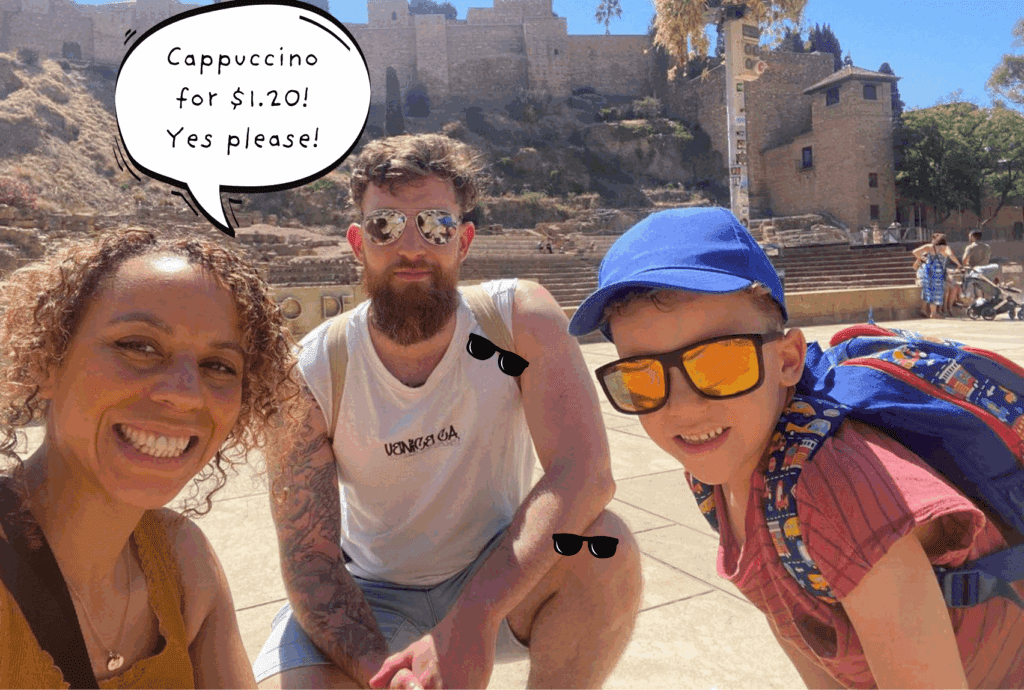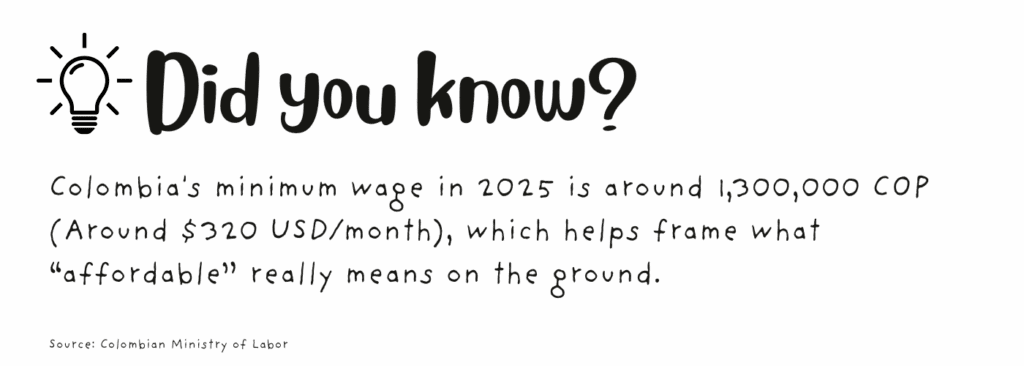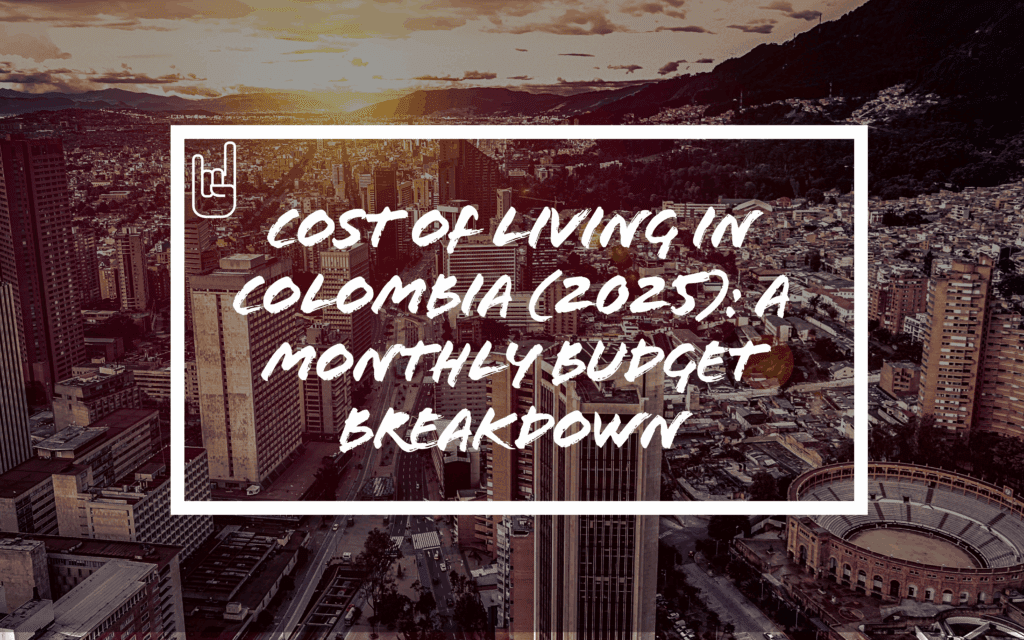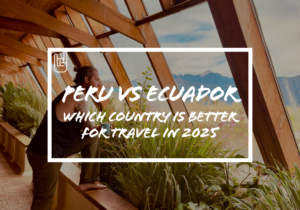Cost of Living in Colombia (2025): A Monthly Budget Breakdown
Wondering if Colombia is still affordable for long-term travel in 2025? We haven’t landed yet but after weeks of research and family-focused budgeting, here’s what the numbers (and our spreadsheet) are telling us.
Quick Overview: How Much Does It Cost to Live in Colombia?
We’ve looked at the numbers. Cross-checked cities. Compared SIM card costs to snack prices. And while we haven’t arrived yet, our budget definitely has.
If you’re wondering what it really costs to live in Colombia in 2025, here’s the big picture based on current Numbeo data and what it means for families, couples, and anyone doing more than a quick holiday:
Single person: £385/month (not including rent)
Family of four: ~£1,342/month (not including rent)
Rent? Add another £250–£500/month depending on city and location
Overall: 57% cheaper than the UK, with rent costs up to 72% lower
That means Colombia currently sits in the “yep, it’s still affordable” camp, especially for long-term travellers, remote workers, or slow-travel families.
But like anywhere, cost varies wildly depending on your pace and place. Medellín and Cali offer different vibes (and rent brackets) than Bogotá, and if you’re planning to slow down, that stretch-your-budget effect gets even stronger.
We’ll break it all down below, rent, food, transport, the lot, but if you’re just here to gut-check the budget: yes, Colombia still makes the long-term travel list, especially if you’re trading high costs for high altitude and daily mangoes.
Table of Contents
Rent in Colombia: How Much for a Decent Apartment?
We’re not out there yet, but you better believe we’ve had every “Medellín Airbnb” tab open since January. And here’s what the numbers and our late-night scrolls are telling us.
According to Numbeo, average rent prices in Colombia (as of 2025) are significantly lower than the UK. In fact, the cost of renting a decent 1- to 3-bedroom apartment is between £200 and £500/month, depending on location, size, and whether you’re in the centre of a major city or just outside.
Example Rental Prices (City vs Suburbs)
(Prices based on Numbeo recent 2025 data)
1-bed apartment (city centre): £240–£300/month
1-bed apartment (outside centre): £180–£220/month
3-bed apartment (city centre): £400–£550/month
3-bed apartment (outside centre): £300–£420/month
Medellín and Cali tend to be more affordable for longer stays, with more modern options for digital nomads and expats. Bogotá? Higher cost, more traffic, but still drastically cheaper than London, Leeds, or anywhere in the UK really.
We’ve factored around £600/month for a 2–3 bed place in a good area, walkable, safe, and not falling apart but it’s the kind of cost that leaves breathing room for actual life. That alone is rare.
If you’re planning to rent monthly or long-term, you’ll find way better deals than anything listed on Airbnb. Facebook groups and local sites are where the real options live. (And yes, we’ll update this once we’re actually in-country and testing Wi-Fi speeds ourselves.)
Found this useful? Help keep our family travel blog ad-free by buying us a coffee.
Food Costs in Colombia: Markets vs Eating Out

If there’s one part of the Colombian cost-of-living research that made us pause (and drool a bit), it’s food. Whether you’re grabbing lunch for £3 or buying a week’s worth of mangoes for under a fiver, Colombia makes it surprisingly easy to eat well on a budget, even with kids who are basically full-time snack machines.
Here’s what we’ve gathered from current Numbeo data and obsessive menu scanning:
🛒 Grocery basics (mid-range supermarket):
Milk (1L): £0.95
Eggs (12): £1.80
Local cheese (1kg): £3.50
Rice (1kg): £1.10
Chicken breast (1kg): £4.30
Loaf of fresh bread: £1.20
🍽️ Eating out
Inexpensive lunch (menu del día): £3–£4
Mid-range dinner for two: ~£20–£25
McMeal: £6
Cappuccino: £1.20
Street food in cities like Medellín and Cartagena is everywhere and cheap. You can easily grab empanadas, arepas, or fresh juice for under £2. And while not every child wants a tamal over toast, the general cost of feeding a family here looks less stressful than in, say, Lisbon or Barcelona.
For budgeting, we’re planning about £300/month on food for the four of us, with a mix of home-cooking, markets, and the occasional “please just bring me coffee and carbs” cafe trip.
We’ll report back from the avocado aisle when we land, but if Colombia delivers on its cost-friendly food rep, we’ll be very full and very happy.
Utilities, Internet & Mobile: Low But Reliable
We’ve budgeted for a lot: new swim shoes, extra snacks, a backup stash of kid plasters. But utilities? That one’s actually straightforward and, thankfully, affordable.
Based on current Numbeo data for Colombia in 2025, basic utilities (electricity, water, gas, and garbage) for a standard 85m² apartment range from £60 to £90/month depending on the city and climate. Medellín, for example, often needs no heating or cooling thanks to its “eternal spring” weather, which keeps costs lower. Bogotá, with its chillier nights, might push those numbers up slightly.
Internet?
A 60 Mbps+ connection with unlimited data averages around £18–£22/month, cheaper than UK rates and totally workable for digital nomads or remote workers. Speeds do vary, so it’s worth checking reviews before you book a long-term stay, especially if you’re relying on video calls or content uploads.
📱 Mobile plans
(10GB–15GB with calls/texts) are also budget-friendly, starting around £6–£10/month, depending on the provider. Claro, Movistar, and Tigo are the main players. Prepaid SIMs are widely available, and topping up is easy, often done at corner stores or even online.
For us, we’re planning roughly £100/month total for utilities + internet + two prepaid mobile lines, which gives us room for flexibility without any surprises. As always, we’ll test it properly once we’re on the ground, but right now? Colombia’s monthly running costs look refreshingly unproblematic.
Note: If you book with Airbnb, then utilities and internet are not something you need to overthink as they’re baked into the costs.

Transport Costs: Cheap Local Travel
Colombia’s not the place where you need a car, it’s the place where you really don’t want one. And from a budgeting perspective, that’s a win.
Thanks to Numbeo and enough Reddit threads to make our eyes blur, here’s what we’re seeing: getting around in Colombia is refreshingly affordable, especially if you’re basing yourself in a city with decent infrastructure (think: Medellín, Bogotá, Cali).
Here’s the breakdown:
🚌 Local transport (bus or metro): ~£0.60 per ride
🛂 Monthly transport pass: ~£30
🚕 Taxi start fare: ~£1.30 + £0.50/km
⛽ Gasoline (1L): ~£0.80
Medellín in particular has a reputation for the best public transport in the country, thanks to its metro and cable car network, a rare and functional gem in Latin America. Bogotá’s traffic is legendary (read: not in a good way), but the TransMilenio bus system is still an affordable option for city travel if you don’t mind a bit of chaos.
For families, we’ve budgeted ~£100–£120/month for all transport, which includes local buses, taxis when needed, and occasional intercity buses (which are both scenic and cost-effective). Example: Cali to Medellín by coach runs around £10–£15 per person.
We’re not planning to rent a car — partly for cost, partly for sanity but will get one if needed. Instead, we’ll lean on public transport, walkable neighbourhoods, and the occasional “ride home because the kids are melting down” taxi.

Education & Childcare (for Families & Nomads)
This is the section where our search history got weirdly specific: “bilingual kindergarten Medellín”, “international school with flexible terms”, and yes — “how to not go broke educating kids abroad”.
Colombia isn’t the cheapest country for international education, but it’s far from the most expensive either. And for long-term travellers or remote-working families, it’s one of the more flexible, especially if you’re mixing local experiences with home learning.
Here’s what we’ve gathered from Numbeo, expat forums, and school listings:
Also read: Cheapest Countries in South America for Families
Childcare + Preschool (Private)
Full-time preschool (private): £220–£400/month per child
Local Colombian preschools are far more affordable than international ones, and offer immersion opportunities if you’re planning to stay for more than a few months
International Schools
Annual tuition: £4,700–£8,500/year depending on city and curriculum (American, British, or IB)
Most schools are in Bogotá and Medellín
Some offer short-term enrolment or “traveller family” options, but you’ll need to enquire directly
What We’re Considering
For our setup, we’re leaning toward a mix of worldschooling + worldschooling groups and get-togethers — especially in cities where we’ll stay for 6+ weeks. That gives our kids the chance to socialise and adapt without locking into year-long commitments (or blowing the budget).
We’re need to look into if there will be any cost as i know there are some paid world schooling communities and then other where its a meetup and get together etc
Bonus Living Costs: Fitness, Fun & Unexpected Extras
Let’s be honest, the daily costs are one thing. But it’s the little lifestyle stuff that sneaks into your budget when you’re not looking: gym sessions, coffee refills, chocolate bribes, and the occasional “we can’t cook tonight” decision.
Here’s what we’ve priced in, based on 2025 data from Numbeo and local expat recommendations:
Fitness & Wellness
Gym membership: ~£20/month
Most major cities have affordable, well-equipped gyms. Medellín has several geared toward digital nomads and expats with flexible access.Yoga class or drop-in fitness: £3–£5/session
Cheaper if you find local studios or class packs.- Some Airbnb apartment complexes have their own gym so something to think about too.
Cafes, Cinema & Extras
Cappuccino: £1.20
A completely justifiable daily spend if you’re working from a café and need one hot cup to survive.Cinema ticket: £3.50–£4.50
Surprisingly affordable, especially if you’re in a chill zone and just need to parent-watch a Pixar film in peace.Domestic beer: £0.90
Bottle of mid-range wine: £8–£15
Let’s be real, a few drinks a week sneak into the budget, especially post-bedtime.

The Family Factor
We’ve factored in around £100–£150/month for extras like entertainment, activities, and the occasional “we’ve earned this” outing. While long-term travel is budget-friendly, it’s not no-fun, and we still want to enjoy it.
This part of the budget is flexible by design, and honestly, it’s what makes the rest of it sustainable.
Is Colombia Affordable in 2025? Our Take
We haven’t landed yet, but if spreadsheets told stories, ours would be saying: Colombia’s not just affordable, it’s doable.
Based on everything we’ve researched so far, Colombia still sits in that sweet spot for long-term travellers: low living costs, decent infrastructure, and a lifestyle that lets you live instead of just scrape by. It’s not Southeast Asia-cheap, but for a family of four coming from the UK, it’s a massive financial breather.
Who this is ideal for:
Digital nomads who need decent Wi-Fi and great coffee
Slow-travel families who don’t want to burn through savings
Couples or solo travellers looking for cultural depth without London-level rent
And yes, it has challenges too. Altitude in Bogotá, the infamous traffic, adjusting to safety rhythms in certain areas. But overall? The value is still there.
If you’re thinking about Colombia for a month, six months, or as part of a longer route through South America, this is one of those places where your budget stretches without your quality of life shrinking. And for us, still in the planning trenches, that feels like the kind of foundation we can build from.






